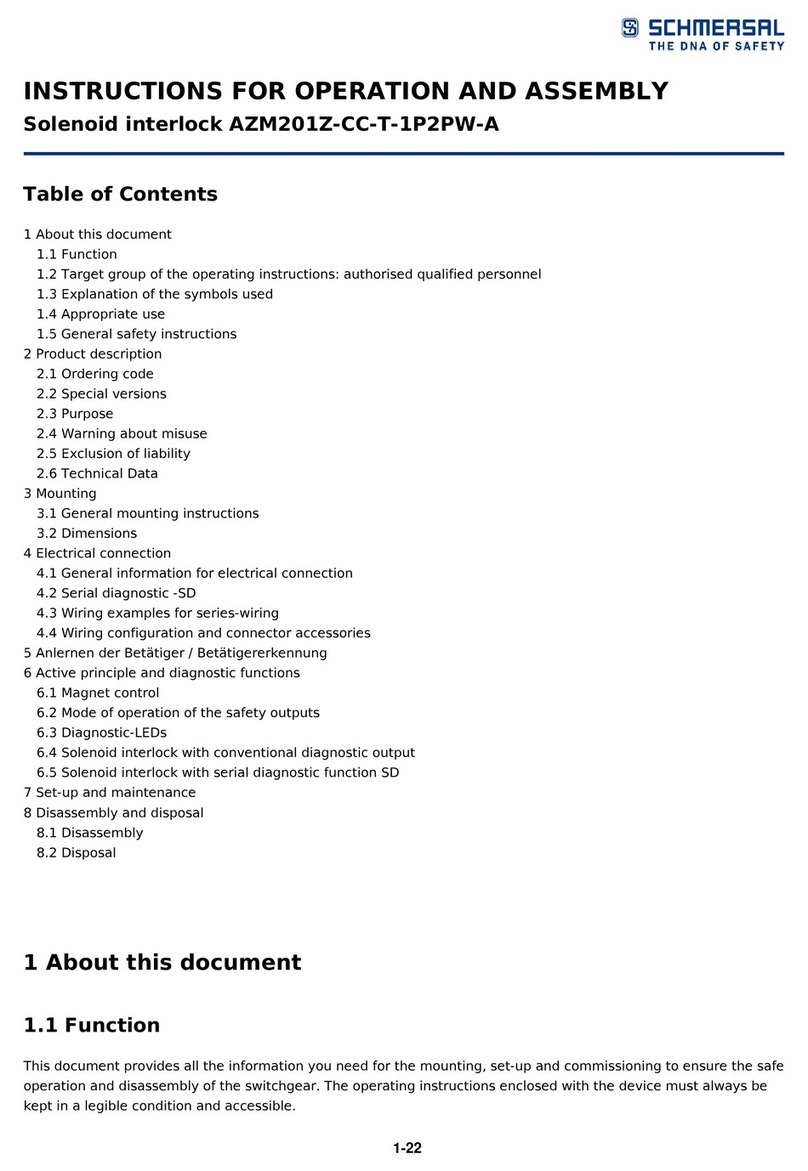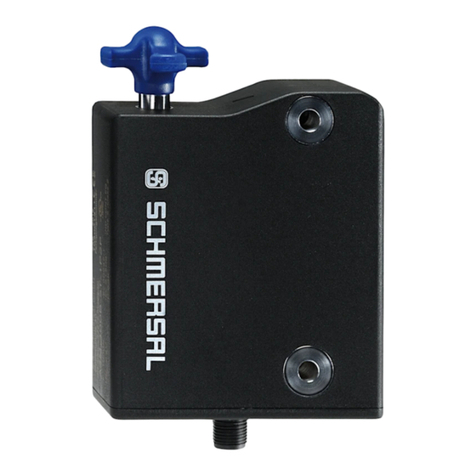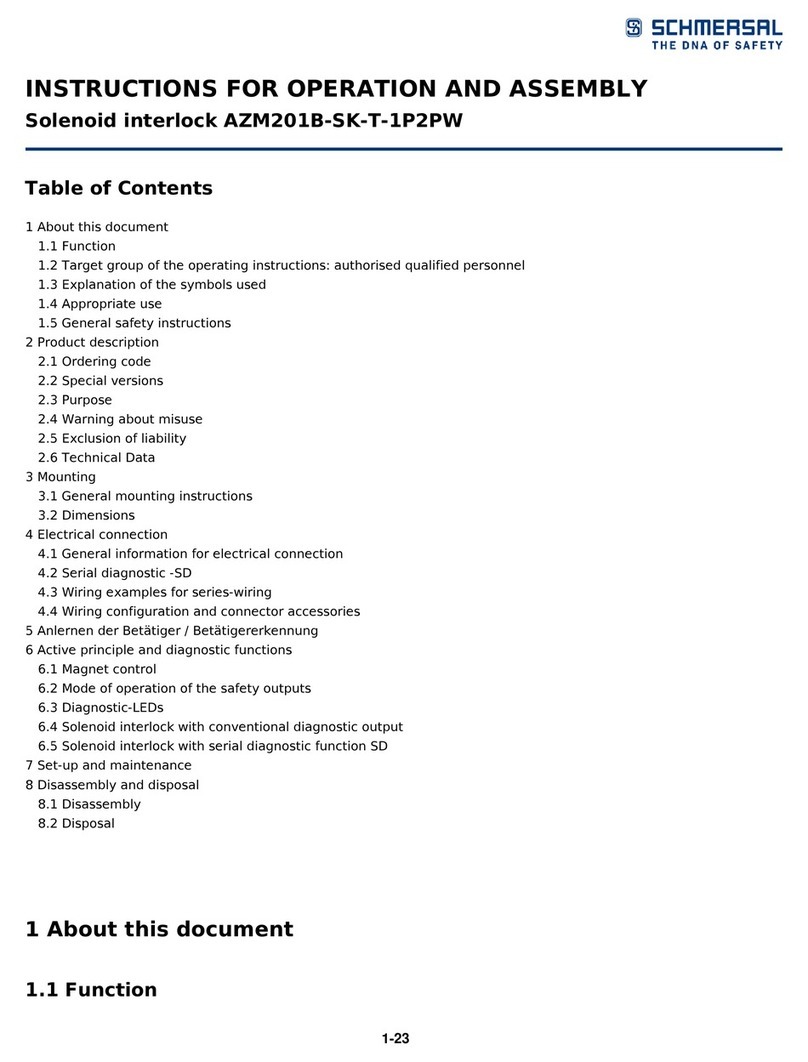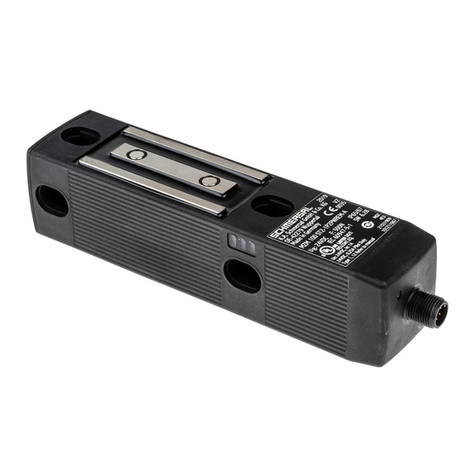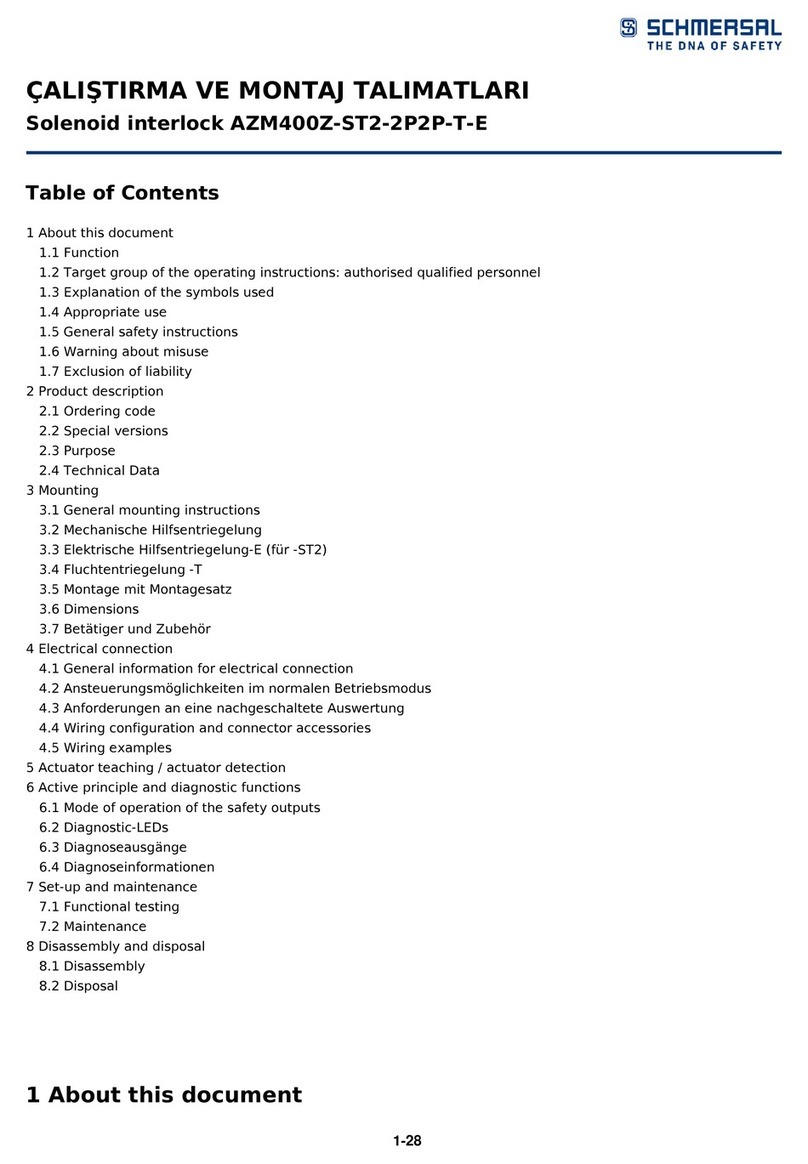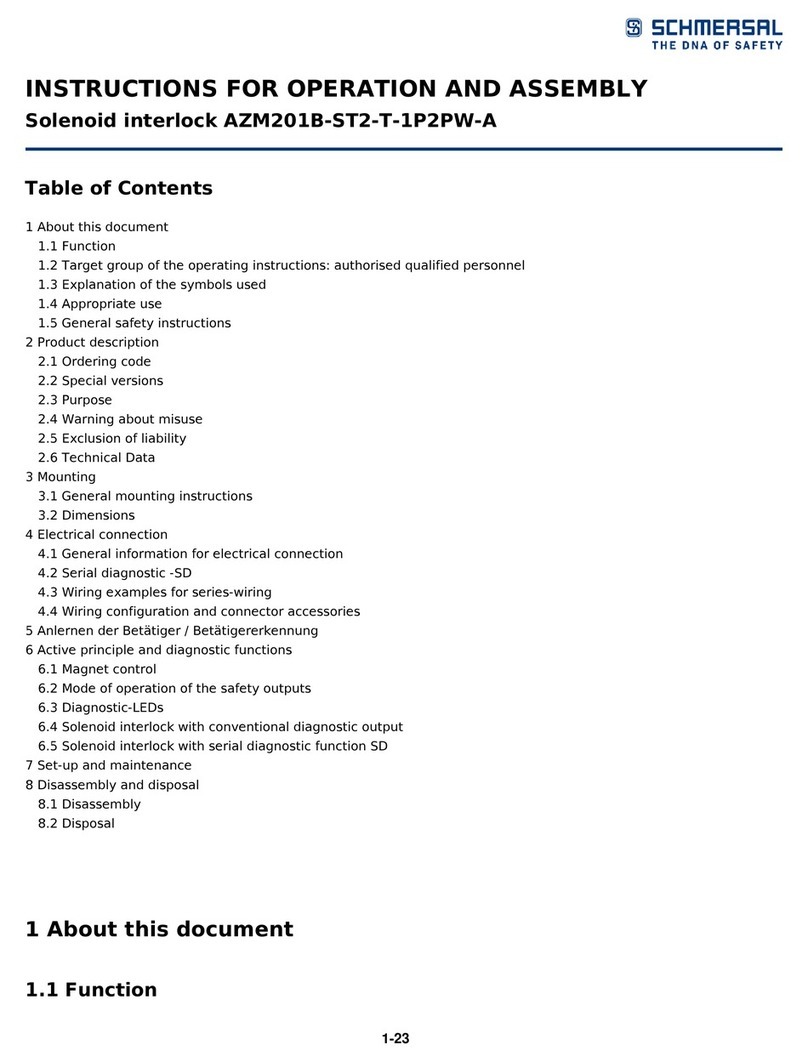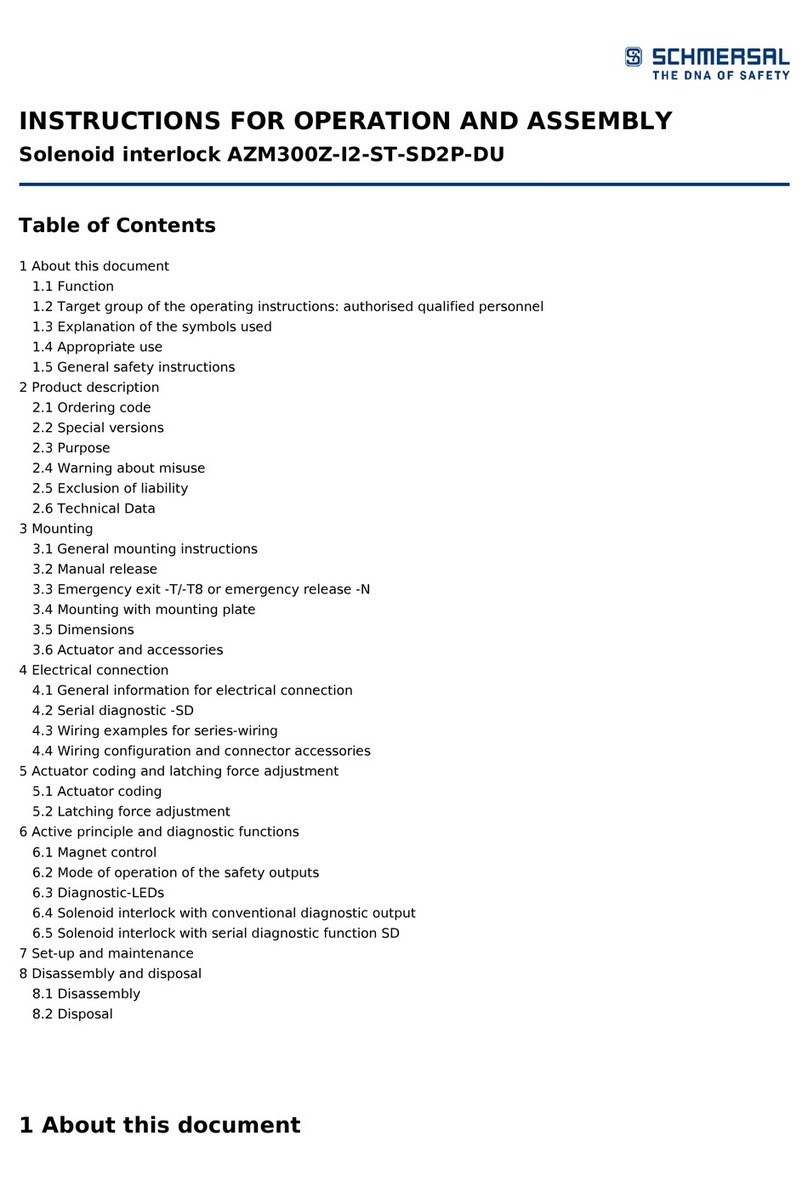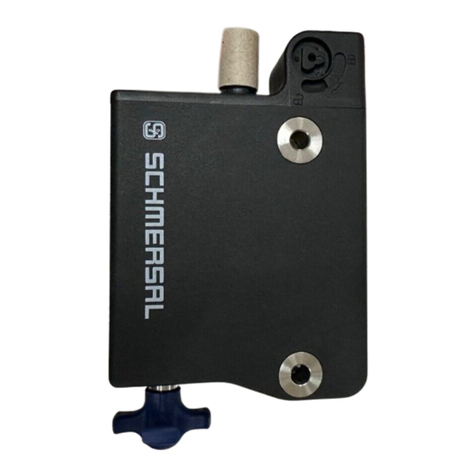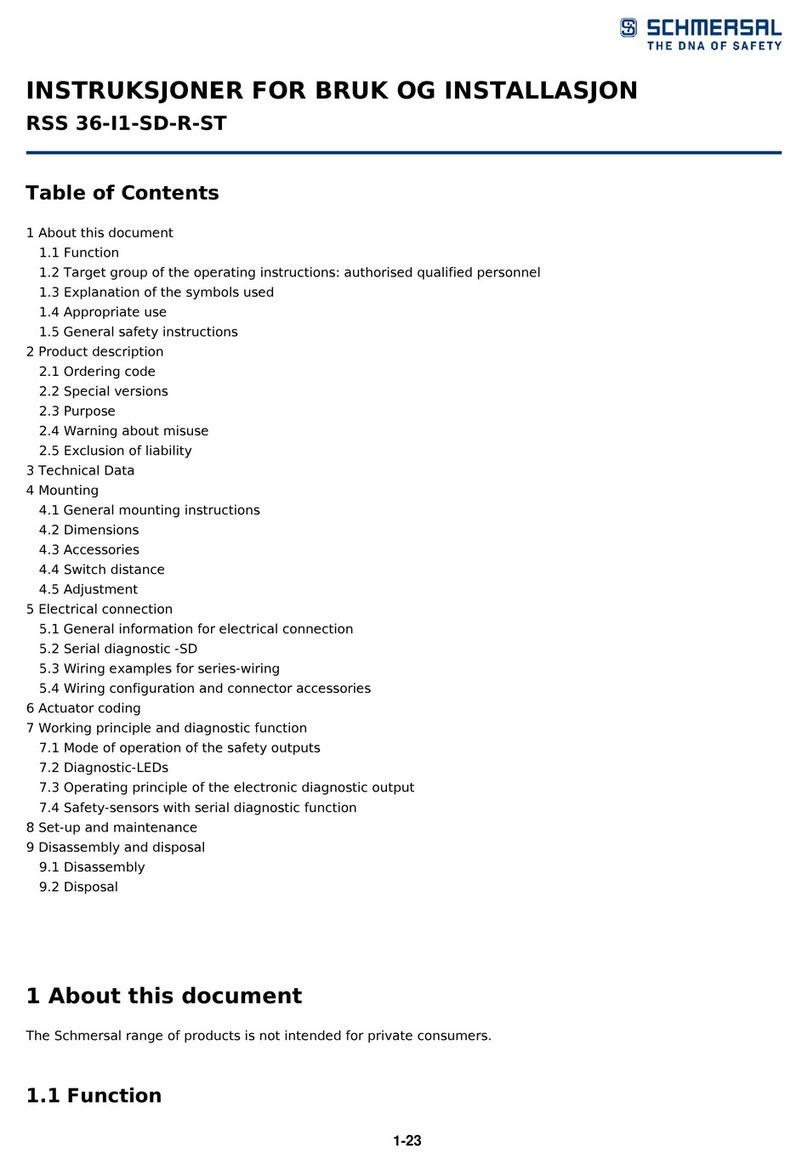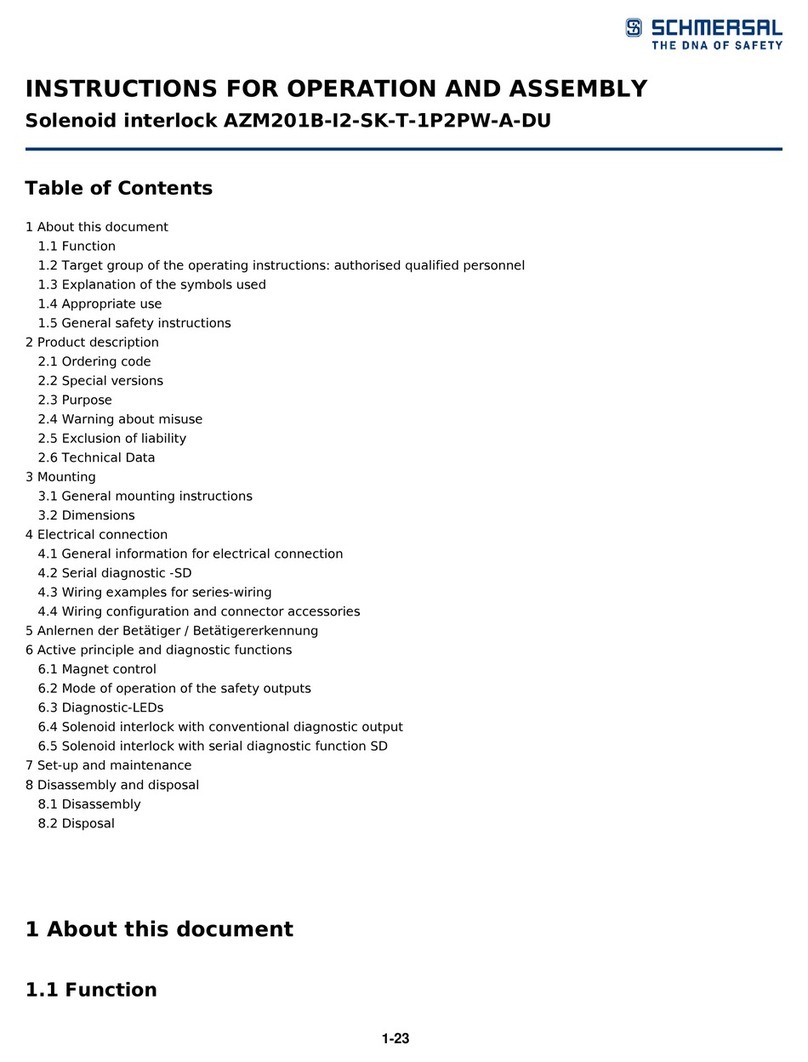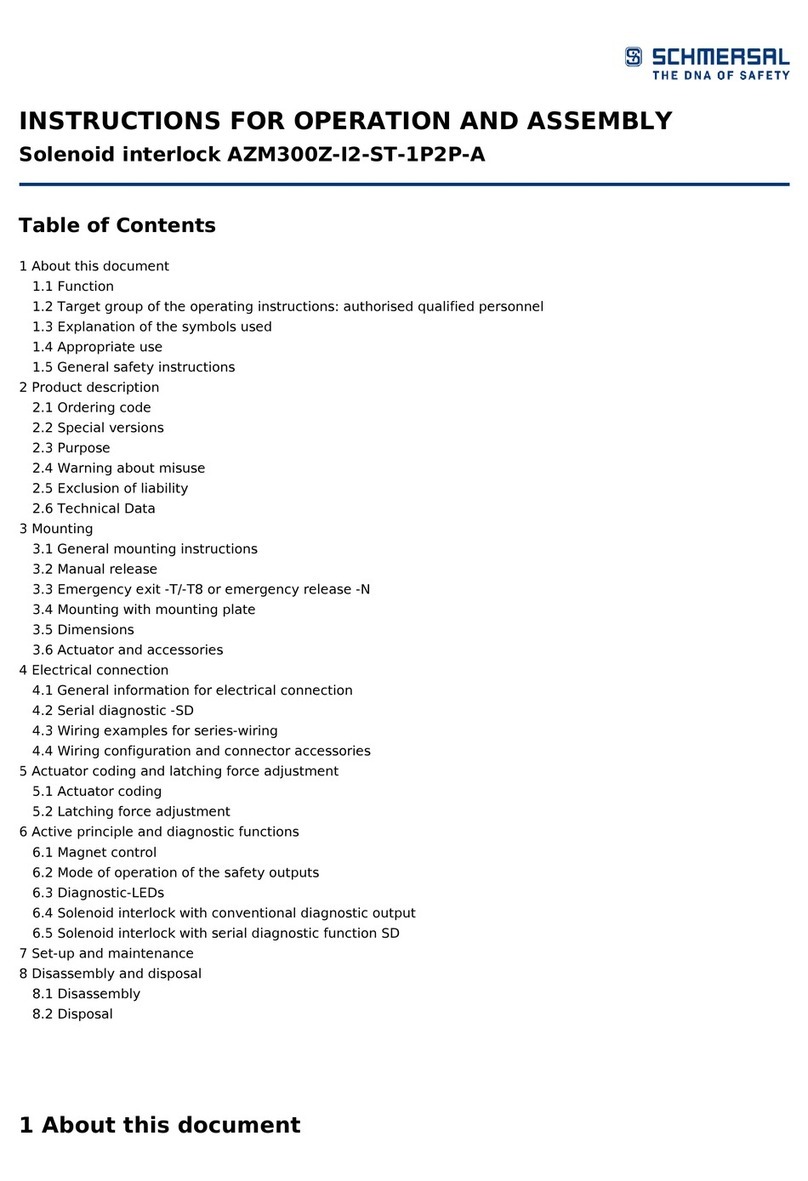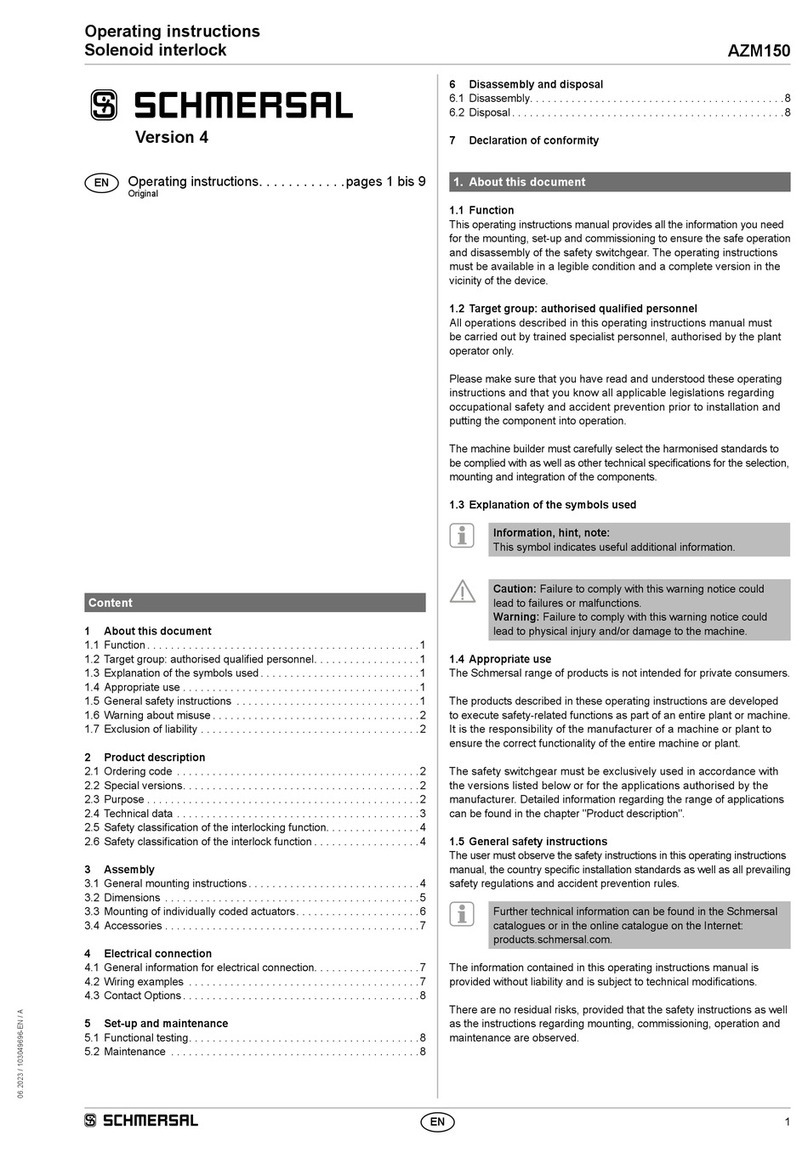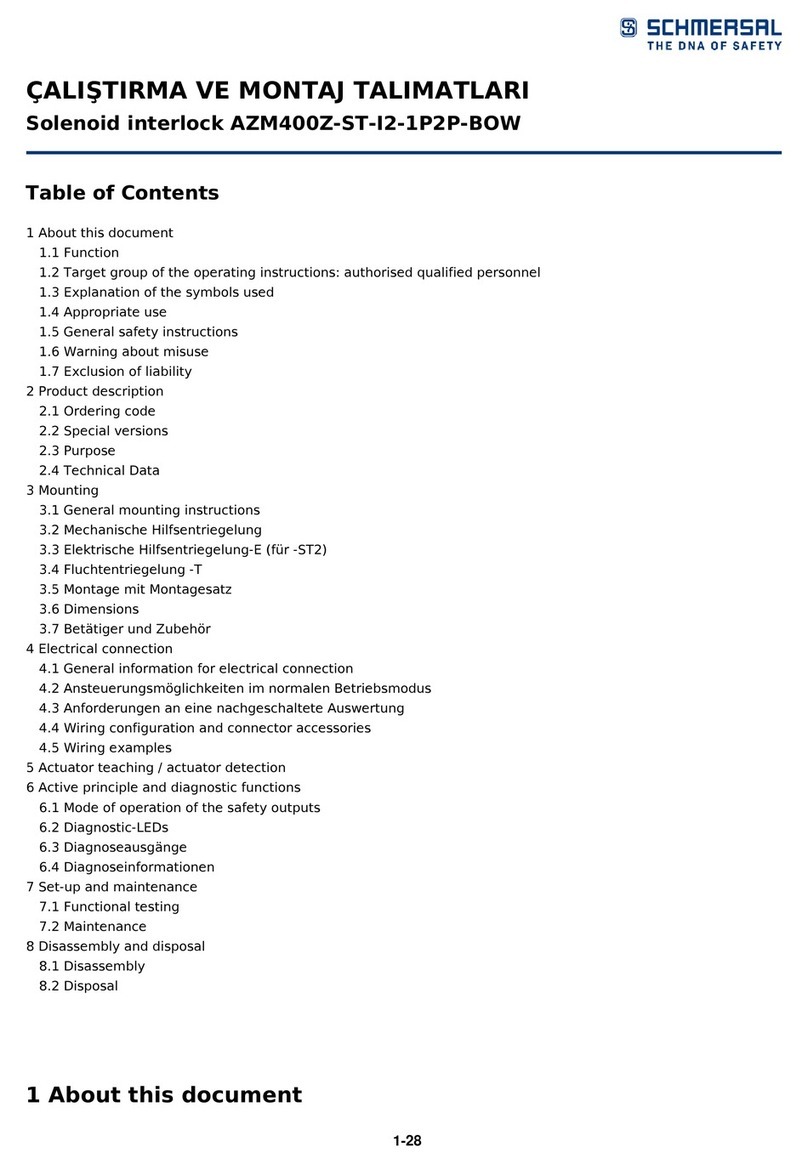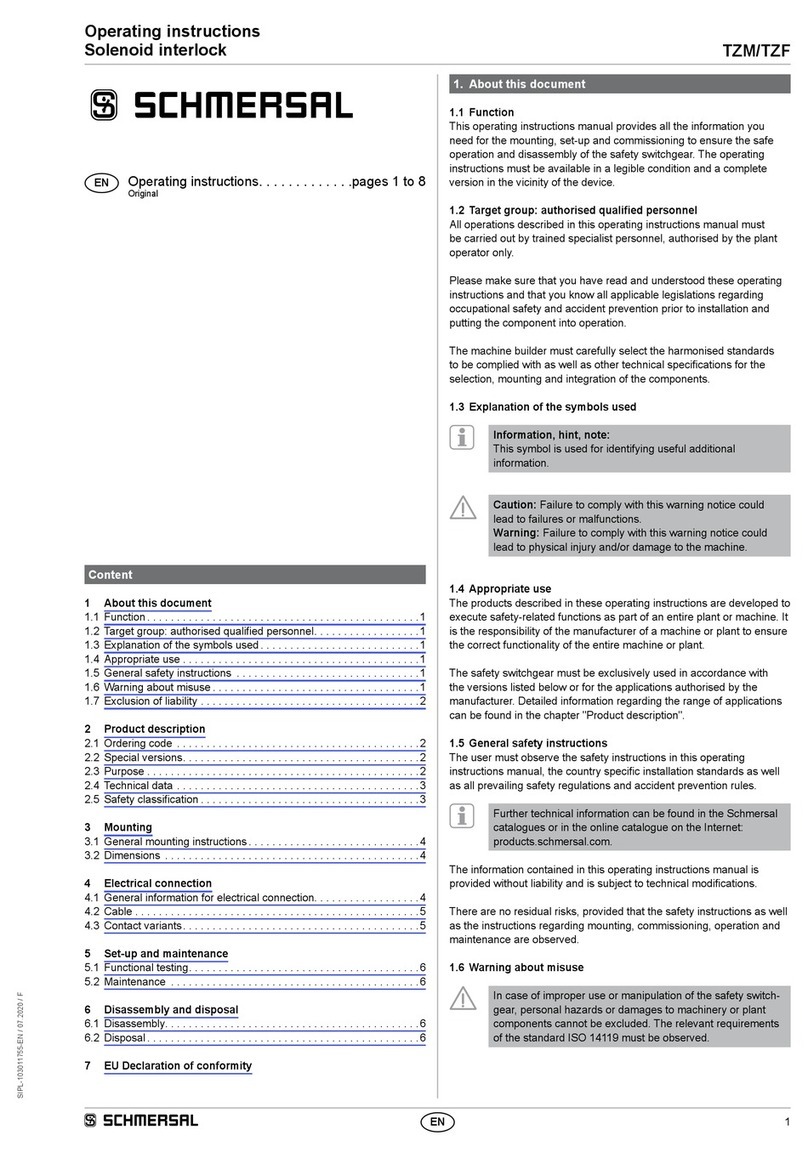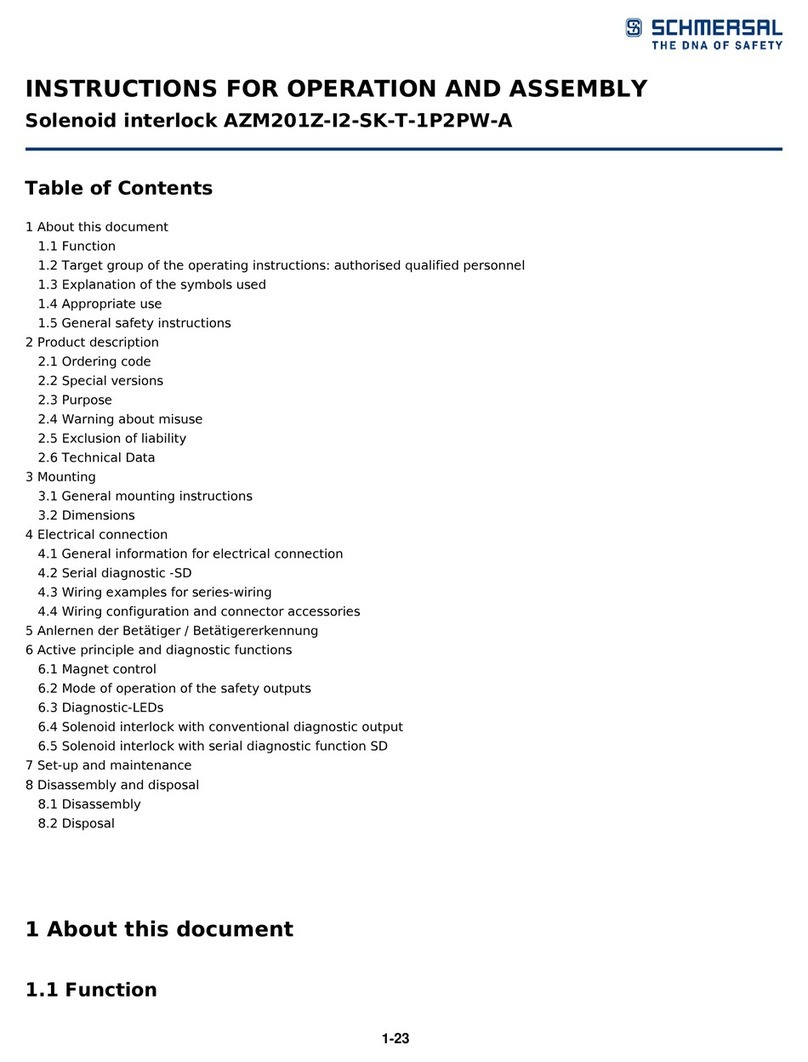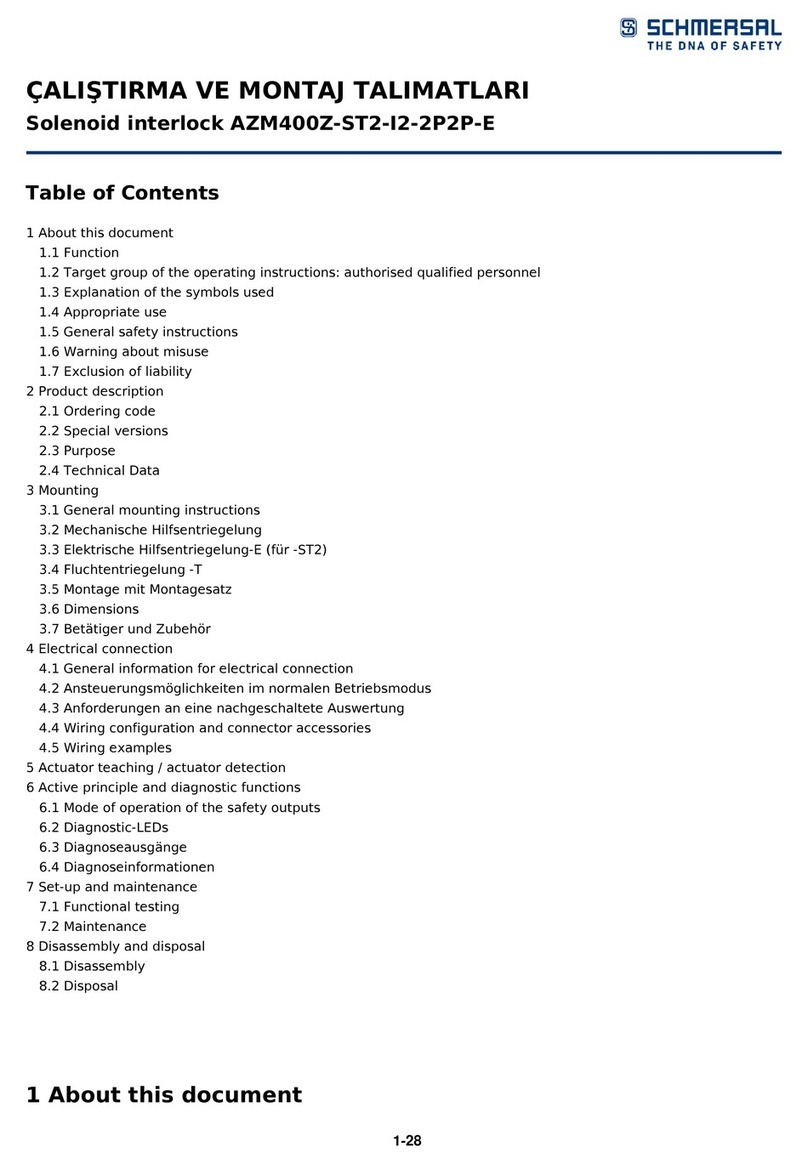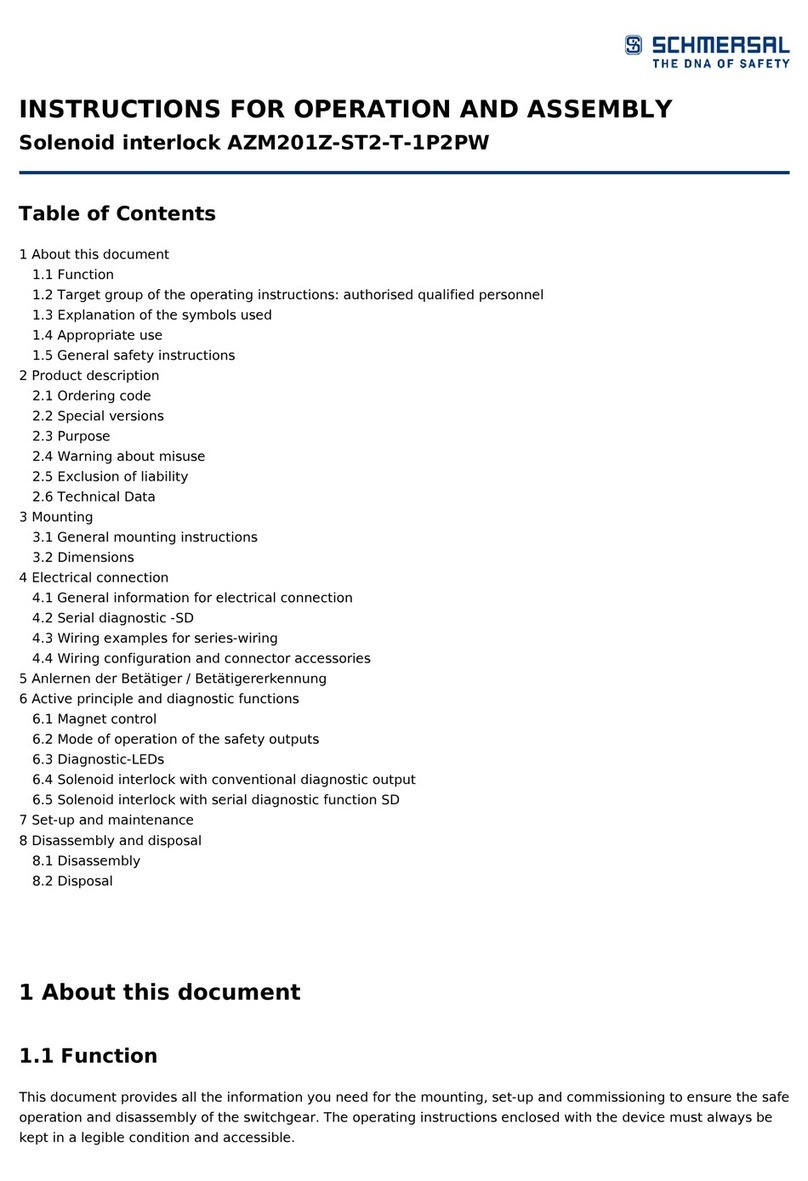
3
EX-AZM300
Operating instructions
Solenoid interlock
EN
2.5 Technical data
Designation in accordance with the ATEX Directive: DII 3GD
Designation in accordance with standards: Ex nA IIB T5 Gc
Ex tc IIIB T95°C Dc X
Applied standards: IEC 60947-5-1, IEC 60947-5-3, ISO 14119,
EN 60079-0, EN 60079-15, EN 60079-31
ISO 13849-1, IEC 61508, IEC 62061
Enclosure: glass-fibre reinforced thermoplastic, self-extinguishing
Working principle: RFID
Frequency band: 125 kHz
Transmitter output: max. -6 dBm
Coding level according to ISO 14119:
- I1-version: high
- I2-version: high
- Standard coding version: low
Reaction time:
- Actuator: ≤ 100 ms
- Inputs: ≤ 0.5 ms
Duration of risk: ≤ 200 ms
Time to readiness: ≤ 5 s
Series-wiring: Unlimited number of components,
please observe external cable protection,
max. 31 components in case of serial diagnostics
Length of the sensor chain: max. 200 m
Mechanical data
Connection: Connector plug M12, 8-pole, A-coded
Max. impact energy: 7 J with CL/CR protective enclosure
Mechanical life: ≥ 1,000,000 operations
- when used as door stop: ≥ 50,000 operations
for safety guards ≤ 5 kg
and actuating speed ≤ 0.5 m/s
Angular misalignment between
solenoid interlock and actuator: ≤ 2°
Fixing screws: V4A, 2 x M6, strength class 8.8
Tightening torque of the fixing screws: 8 Nm
Latching force: 25 N / 50 N
Holding force Fmax:1.500 N
Holding force FZh:1.150 N
Switching distances to IEC 60947-5-3:
Typical switching distance sn:2 mm
Assured switching distance sao:1 mm
Assured switch-off distance sar:20 mm
Ambient conditions
Ambient temperature: 0 °C … +50 °C
Storage and transport temperature: −10 °C … +90 °C
Protection class: IP66 / IP67 / IP69 to IEC 60529
Protection class: III
Resistance to shock: 30 g / 11 ms
Resistance to vibration: 10 … 150 Hz, Amplitude 0.35 mm
Insulation values to IEC 60664-1:
- Rated insulation voltage Ui:32 VDC
- Rated impulse withstand voltage Uimp:0.8 kV
- Over-voltage category: III
- Degree of pollution: 3
Maximum switching frequency: 0.5 Hz
Electrical Data
Operating voltage UB:24 VDC –15 % / +10 %
(stabilised PELV power supply)
Power consumption device: < 0.1 A
Operating current device with magnet switched on:
- Peak current: < 0.35 A / 200 ms
- Averaged: < 0.2 A
Required rated short-circuit current: 100 A
External Device fuse rating: 2 A (T)
Electrical data – Safety inputs
Safety inputs: X1 and X2
Switching thresholds: −3 V … 5 V (Low),
15 V … 30 V (High)
Current consumption per input: ≤ 5 mA / 24 V
Accepted test pulse duration on input signal: ≤ 1.0 ms
- With test pulse interval of: ≥ 100 ms
Classification: ZVEI CB24I
Sink: C1 Source: C1 C2 C3
Electrical data – Safety outputs
Safety outputs: Y1 and Y2
Switching elements: p-type, short-circuit proof
Utilisation category: DC-12: Ue/Ie: 24 VDC / 0.25 A
DC-13: Ue/Ie: 24 VDC / 0.25 A
Rated operating current Ie:0.25 A
Leakage current Ir: ≤ 0.5 mA
Voltage drop Ud: ≤ 4 V
Cross-wire monitoring by device: Yes
Test pulse duration: ≤ 0.3 ms
Test pulse interval: 1,000 ms
Classification: ZVEI CB24I
Source: C2 Sink: C1 C2
Electrical data - Diagnostic output
Diagnostic output: OUT
Switching element: p-type, short-circuit proof
Utilisation category: DC-12: Ue/Ie: 24 VDC / 0.05 A
DC-13: Ue/Ie: 24 VDC / 0.05 A
Rated operating current Ie:0.05 A
Voltage drop Ud: ≤ 4 V
Serial diagnostic SD
Operating current: 0.15 A
Wiring capacitance: max. 50 nF
Electrical data – Magnet control
Solenoid input: IN
Switching thresholds: − -3 V … 5 V (Low),
5 V … 30 V (High)
Power consumption: 10 mA / 24 V
Magnet switch-on time: 100 %
Accepted test pulse duration on input signal: ≤ 5.0 ms
- With test pulse interval of: ≥ 40 ms
Classification: ZVEI CB24I
Sink: C0 Source: C1 C2 C3
LED switching conditions display
green LED: Supply voltage
yellow LED: Device condition
red LED: Fault
2.6 Safety classification
- of the interlocking function:
Standards: ISO 13849-1, IEC 61508, IEC 62061
PL: e
Control Category: 4
PFH value: 5.2 x 10-10 / h
PFD: 4.5 x 10-5
SIL: suitable for SIL 3 applications
Mission time: 20 years
- of the guard locking function:
Standards: ISO 13849-1, IEC 61508, IEC 62061
PL: d
Control Category: 2
PFH value: 2.0 x 10-9 / h
PFD: 1.8 x 10-4
SIL: suitable for SIL 2 applications
Mission time: 20 years
The safety consideration of the guard locking function only
applies for standard devices with monitored solenoid interlock
EX-AZM300Z-…-1P2P-… (see Ordering code). A safety
assessment of the guard locking function for devices with
serial diagnostics "SD2P" is not allowed due to the non-safe
locking/unlocking signal from the SD Gateway
The actuation of the interlock must be compared with the
external OSSD enabler. If a shut-down now occurs due to
an unintentional unlocking this is detected by an external
diagnostic.






